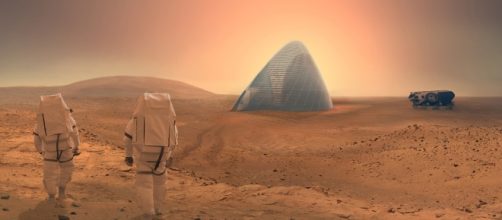The "Mars Ice Home" habitat designed by NASA and the winners of a design contest for the first human mission to Mars in 2030 looks like an igloo and it's also an excellent isolator against cosmic radiation, according to the Huffington Post. On the other hand, the frozen water which will be used to build the igloo can be used as fuel for the spaceship that will bring the people back to Earth at the end of the mission.
13 years before the first human mission to Mars
Even if Mars is the new frontier of cosmic space, the agencies should consider the fact that people cannot be sent there just for a few days, like on the Moon.
Because of the distance, astronauts will need to remain there for more than a year to capitalize on their trip. For this reason, NASA are already thinking about a Martian house for their human mission to this planet which is scheduled to take place in 2030.
Architectural competition for a human habitat on Mars
In 2015, the space agency launched an architectural competition for a three-dimensional habitat that can be created on the red planet and the winner was the "Ice House." More than a year afterwards, NASA developed the concept, which is now called "Mars Ice Dome." NASA experts and the teams of Team Space Exploration Architecture and Clouds Architecture -- the winners of the competition -- have met to discuss the reliability of an ice house on Mars.
The final concept is quite different from the original, which won the competition, according to the Huffington Post.
Advantages of 'Mars Ice Home'
"Mars Ice Home" looks like some kind of igloo. This habitat made of ice will have several advantages. First, water is an excellent insulator against cosmic radiation -- given the fact that this is one of the three main risks on Mars -- according to NASA. The ice will be thicker in the crew compartment, but it will let the light pass, just like the rest of the chosen materials, according to the agency.
But there are two other advantages of using a shell of ice. The first one is that, with the current technology, the water could be extracted from Mars at the level of one cubic meter per day, which means that the so-called igloo could be filled in 400 days.
For this reason, the habitat -- which will be built by robots -- will have to be sent to Mars before the astronauts. The other advantage is that water can be converted into fuel for the spacecraft that will land on Mars. Basically, the igloo will be both a shell of ice and a tank. Inside the ice shell there will be a large ring were the astronauts will live.
Finally, to make sure that the astronauts will not feel too cold, NASA wants to add an isolating blanket of carbon dioxide between the shell and the ice habitat. Then, the astronauts will only have to decorate the habitat and bring the things they need to live on the red planet for about 550 days.

